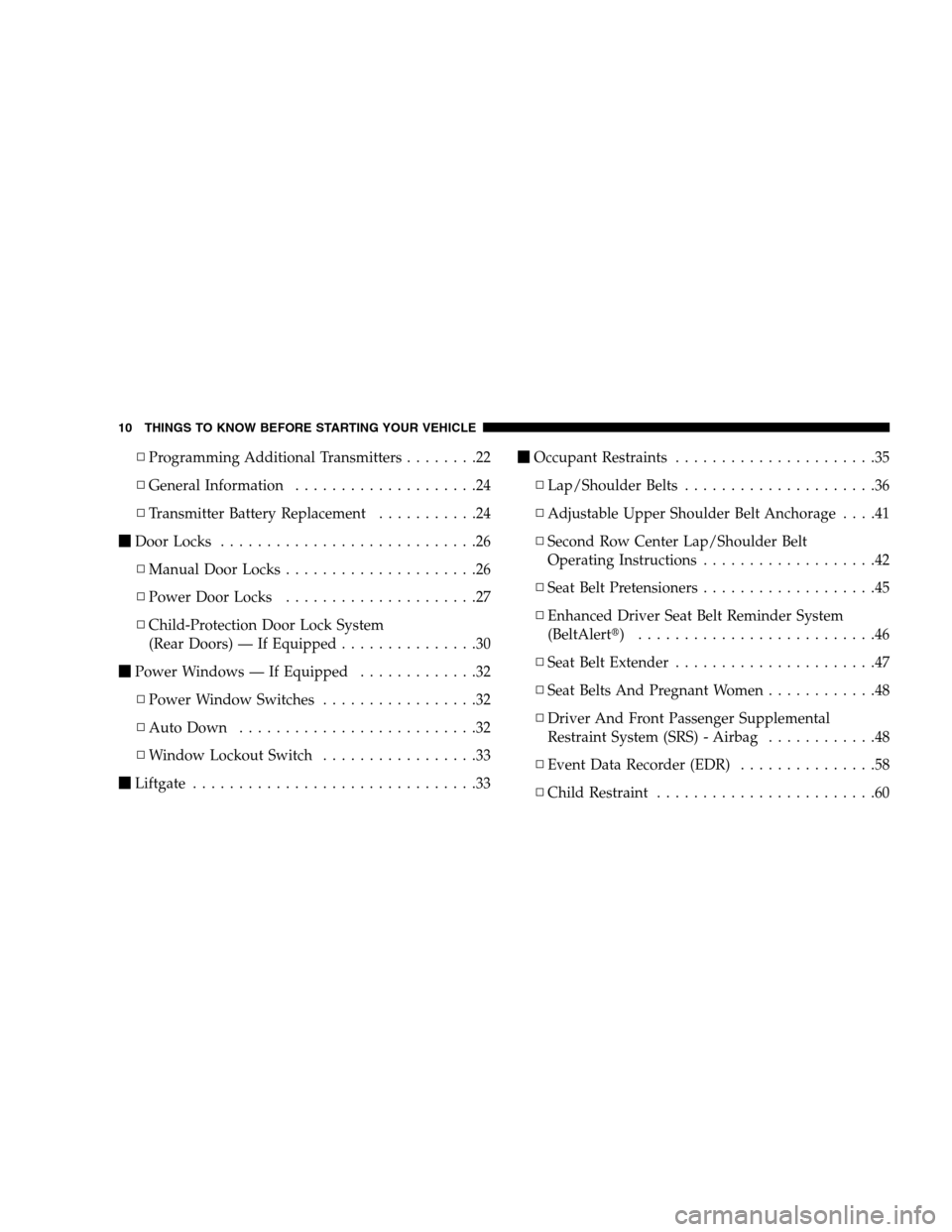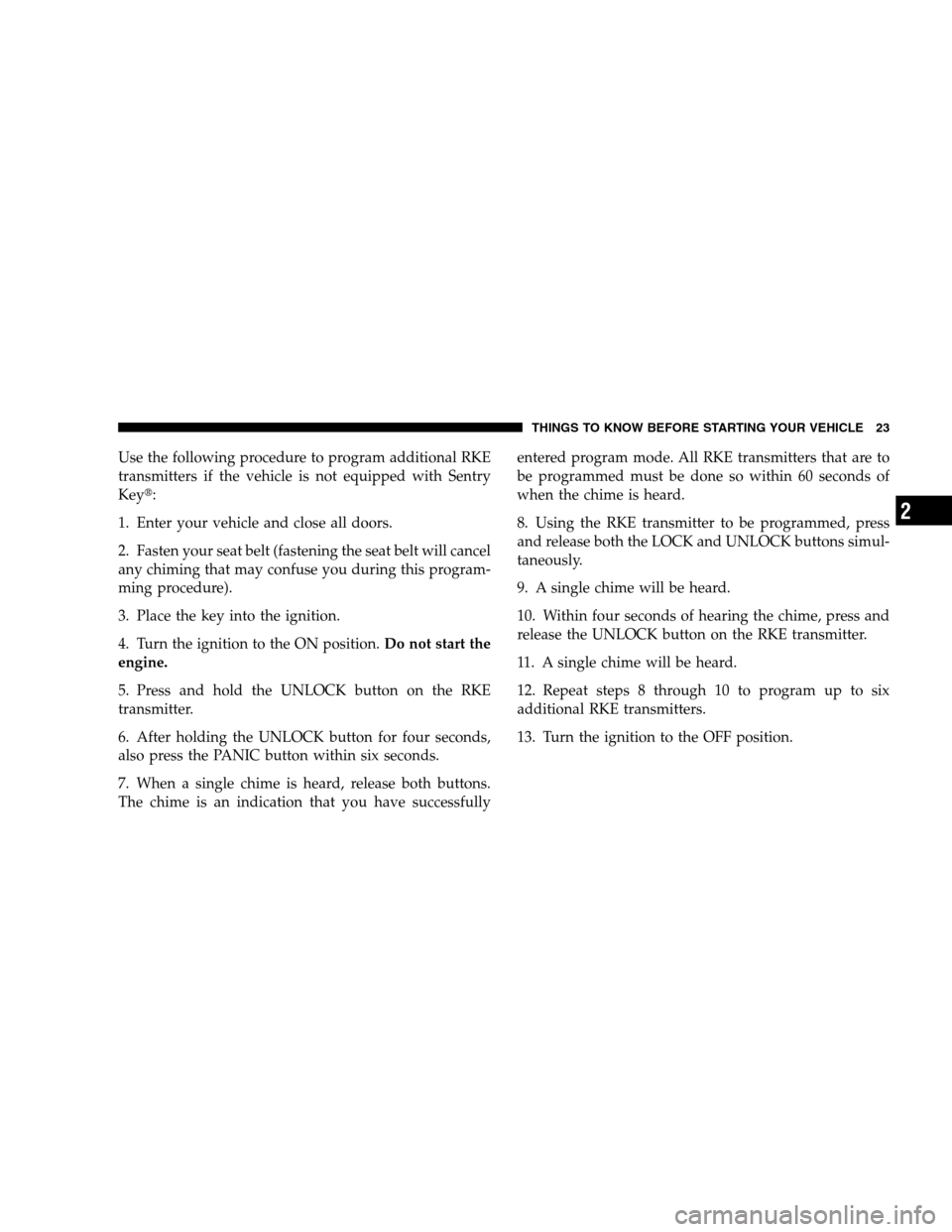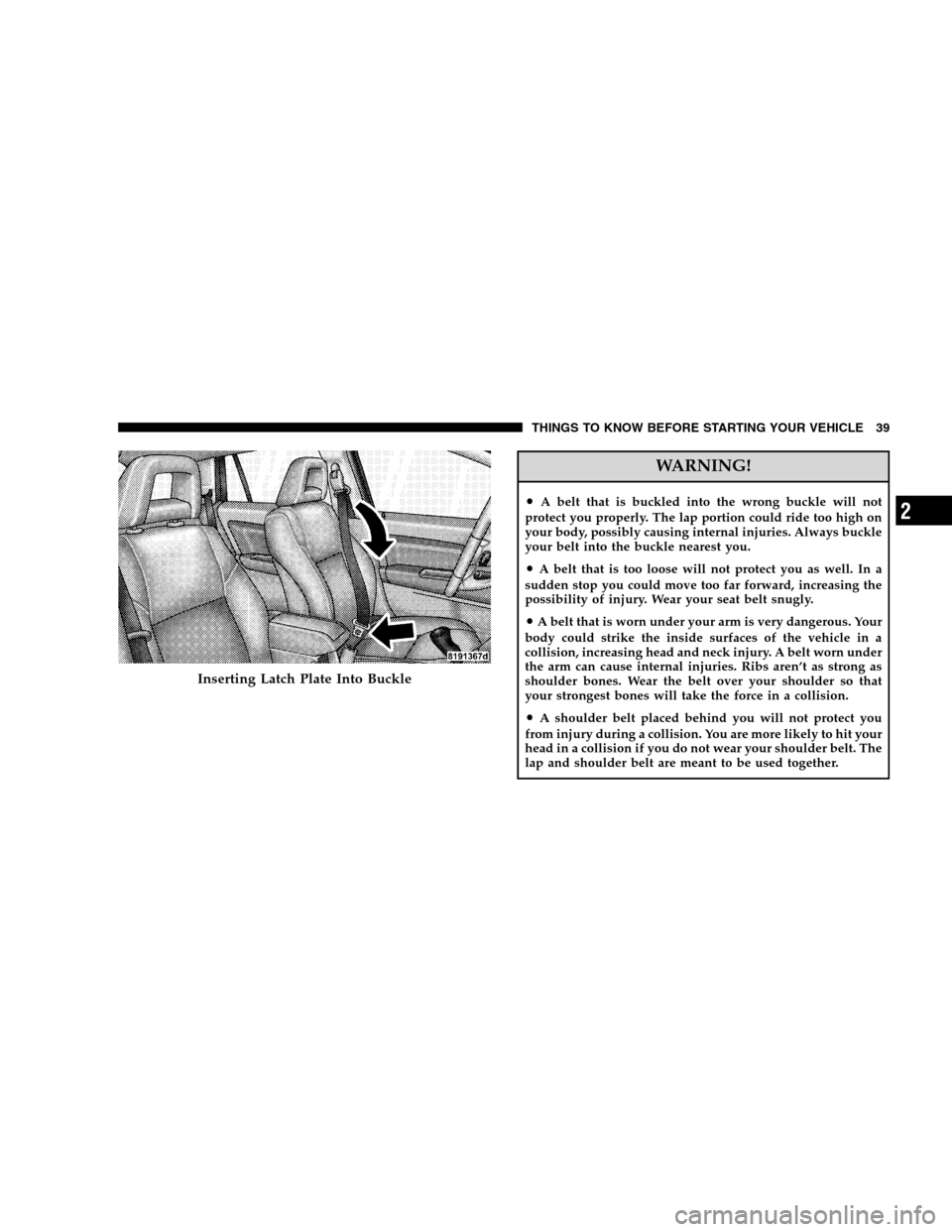Page 7 of 438
Failure to use driver and passenger seat beltsprovided
is a major cause of severe or fatal injury. In fact, the U.S.
government notes that the universal use of existing seatbelts could cut the highway death toll by 10,000 or more
each year and could reduce disabling injuries by two
million annually. In a rollover crash, an unbelted person
is significantly more likely to die than a person wearing
a seat belt. Always buckle up.
HOW TO USE THIS MANUAL
Consult the Table of Contents to determine which section
contains the information you desire.
The detailed index at the back of this Owner’s Manual
contains a complete listing of all subjects.
Consult the following table for a description of the
symbols that may be used on your vehicle or throughout
this Owner’s Manual:
Rollover Warning Label
INTRODUCTION 5
1
Page 12 of 438

▫Programming Additional Transmitters........22
▫General Information....................24
▫Transmitter Battery Replacement...........24
�Door Locks............................26
▫Manual Door Locks.....................26
▫Power Door Locks.....................27
▫Child-Protection Door Lock System
(Rear Doors) — If Equipped...............30
�Power Windows — If Equipped.............32
▫Power Window Switches.................32
▫Auto Down..........................32
▫Window Lockout Switch.................33
�Liftgate...............................33�Occupant Restraints......................35
▫Lap/Shoulder Belts.....................36
▫Adjustable Upper Shoulder Belt Anchorage....41
▫Second Row Center Lap/Shoulder Belt
Operating Instructions...................42
▫Seat Belt Pretensioners...................45
▫Enhanced Driver Seat Belt Reminder System
(BeltAlert�) ..........................46
▫Seat Belt Extender......................47
▫Seat Belts And Pregnant Women............48
▫Driver And Front Passenger Supplemental
Restraint System (SRS) - Airbag............48
▫Event Data Recorder (EDR)...............58
▫Child Restraint........................60
10 THINGS TO KNOW BEFORE STARTING YOUR VEHICLE
Page 25 of 438

Use the following procedure to program additional RKE
transmitters if the vehicle is not equipped with Sentry
Key�:
1. Enter your vehicle and close all doors.
2. Fasten your seat belt (fastening the seat belt will cancel
any chiming that may confuse you during this program-
ming procedure).
3. Place the key into the ignition.
4. Turn the ignition to the ON position.Do not start the
engine.
5. Press and hold the UNLOCK button on the RKE
transmitter.
6. After holding the UNLOCK button for four seconds,
also press the PANIC button within six seconds.
7. When a single chime is heard, release both buttons.
The chime is an indication that you have successfullyentered program mode. All RKE transmitters that are to
be programmed must be done so within 60 seconds of
when the chime is heard.
8. Using the RKE transmitter to be programmed, press
and release both the LOCK and UNLOCK buttons simul-
taneously.
9. A single chime will be heard.
10. Within four seconds of hearing the chime, press and
release the UNLOCK button on the RKE transmitter.
11. A single chime will be heard.
12. Repeat steps 8 through 10 to program up to six
additional RKE transmitters.
13. Turn the ignition to the OFF position.
THINGS TO KNOW BEFORE STARTING YOUR VEHICLE 23
2
Page 37 of 438

WARNING!
•Driving with the liftgate open can allow poison-
ous exhaust gases into your vehicle. You and your
passengers could be injured by these fumes. Keep
the liftgate closed when you are operating the
vehicle.
•If you are required to drive with the liftgate open,
make sure that all windows are closed, and the
climate control blower switch is set at high speed.
DO NOT use the recirculation mode.
Gas props support the liftgate in the open position.
However, because the gas pressure drops with tempera-
ture, it may be necessary to assist the props when
opening the liftgate in cold weather.
OCCUPANT RESTRAINTS
Some of the most important safety features in your
vehicle are the restraint systems. These include the front
and rear seat belts for the driver and all passengers, front
airbags for both the driver and front passenger and if
equipped, side airbags for both the driver and front
passenger. If you will be carrying children too small for
adult-size seat belts, your seat belts or the LATCH feature
also, can be used to hold infant and child restraint
systems.
Please pay close attention to the information in this
section. It tells you how to use your restraint system
properly to keep you and your passengers as safe as
possible.
THINGS TO KNOW BEFORE STARTING YOUR VEHICLE 35
2
Page 38 of 438

WARNING!
In a collision, you and your passengers can suffer
much greater injuries if you are not properly buckled
up. You can strike the interior of your vehicle or other
passengers, or you can be thrown out of the vehicle.
Always be sure you and others in your vehicle are
buckled up properly.
Buckle up even though you are an excellent driver, even
on short trips. Someone on the road may be a poor driver
and cause a collision that includes you. This can happen
far away from home or on your own street.
Research has shown that seat belts save lives, and they
can reduce the seriousness of injuries in a collision. Some
of the worst injuries happen when people are thrown
from the vehicle. Seat belts reduce the possibility ofejection and the risk of injury caused by striking the
inside of the vehicle.Everyonein a motor vehicle should
be belted at all times.
Lap/Shoulder Belts
All the seats in your vehicle are equipped with Lap/
Shoulder Belts.
The belt webbing retractor is designed to lock during
very sudden stops or collisions. This feature allows the
shoulder part of the belt to move freely with you under
normal conditions. But in a collision, the belt will lock
and reduce the risk of you striking the inside of the
vehicle or being thrown out.
36 THINGS TO KNOW BEFORE STARTING YOUR VEHICLE
Page 39 of 438

WARNING!
•It is extremely dangerous to ride in a cargo area,
inside or outside of a vehicle. In a collision, people
riding in these areas are more likely to be seri-
ously injured or killed.
•Do not allow people to ride in any area of your
vehicle that is not equipped with seats and seat
belts.
•Be sure everyone in your vehicle is in a seat and
using a seat belt properly.
WARNING!
•Wearing a seat belt incorrectly is dangerous. Seat
belts are designed to go around the large bones of
your body. These are the strongest parts of your
body and can take the forces of a collision the best.
•Wearing your belt in the wrong place could make
your injuries in a collision much worse. You might
suffer internal injuries, or you could even slide out
of part of the belt. Follow these instructions to
wear your seat belt safely and to keep your pas-
sengers safe, too.
•Two people should never be belted into a single
seat belt. People belted together can crash into one
another in an accident, hurting one another badly.
Never use a lap/shoulder belt or lap belt for more
than one person, no matter what their size.
THINGS TO KNOW BEFORE STARTING YOUR VEHICLE 37
2
Page 40 of 438
Lap/Shoulder Belt Operating Instructions
1. Enter the vehicle and close the door. Sit back and
adjust the seat.
2. The seat belt latch plate is above the back of the front
seat, next to your arm. Grasp the latch plate and pull out
the belt. Slide the latch plate up the webbing as far as
necessary to allow the belt to go around your lap.
3. When the belt is long enough to fit, insert the latch
plate into the buckle until you hear a “click.”
Pulling Out The Latch Plate
38 THINGS TO KNOW BEFORE STARTING YOUR VEHICLE
Page 41 of 438

WARNING!
•A belt that is buckled into the wrong buckle will not
protect you properly. The lap portion could ride too high on
your body, possibly causing internal injuries. Always buckle
your belt into the buckle nearest you.
•A belt that is too loose will not protect you as well. In a
sudden stop you could move too far forward, increasing the
possibility of injury. Wear your seat belt snugly.
•A belt that is worn under your arm is very dangerous. Your
body could strike the inside surfaces of the vehicle in a
collision, increasing head and neck injury. A belt worn under
the arm can cause internal injuries. Ribs aren’t as strong as
shoulder bones. Wear the belt over your shoulder so that
your strongest bones will take the force in a collision.
•A shoulder belt placed behind you will not protect you
from injury during a collision. You are more likely to hit your
head in a collision if you do not wear your shoulder belt. The
lap and shoulder belt are meant to be used together.
Inserting Latch Plate Into Buckle
THINGS TO KNOW BEFORE STARTING YOUR VEHICLE 39
2